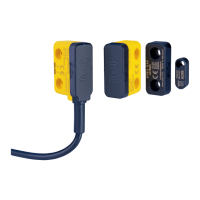Mounting location
b
W
hen the protective device is closed, the sensor and actuator must be located
opposite each other at assured switch-on distance S
ao
or closer (see "Sensing
ranges", page 40).
b
Select a mounting location that allows the sensor and actuator to be accessed for
maintenance work and protects them against damage.
b
If possible, mount the sensor and actuator on non-ferrous subsurfaces and at a
distance from metallic parts in order to avoid affecting the sensing range. If this is
not possible, the effect on the safe switch on distance S
ao
and the safe switch off
distance S
ar
must be checked.
b
Make sure that there is no possibility of hazards arising when the protective device
is opened, even if the actuator has not yet reached the safe switch off distance
S
ar
.
b
If the actuator approaches the sensor in parallel, maintain the minimum distances
(see "Sensing ranges", page 40).
b
If necessary, attach an additional stop for the moving protective device.
Distance
If mult
iple safety switches are mounted on the machine, they must be mounted with a
minimum distance in relation to one another; see "Mounting", page 20.
Alignment
Sensors and actuators can be aligned differently to one another, see "Mounting",
page 20, see "Sensing ranges", page 40. The actuators can point to the front or be
rotated by 90° to the front sensor surface or a side sensor surface.
Approach direction
The actuator can approach the sensor differently:
•
Direct approach
The direction of movement of the actuator is vertical to one of the 3 active sensor
surfaces. No minimum distance must be maintained.
•
P
arallel approach
The direction of movement of the actuator is parallel to the long side of the sensor.
A minimum dis
tance must be maintained.
Due to the principle, the response range of the sensor has side lobes. If the mini‐
mum distance is not maintained, the OSSDs switch to the ON state before the cor‐
rect position is reached. SICK recommends doing without parallel approach if you
cannot maintain a minimum distance.
4.3.1 Different sensing ranges
Different sensing ranges
•
A
ssured switch-on distance S
ao
If the actuator approaches the sensor and reaches the assured switch-on dis‐
t
ance, the OSSDs safely switch to the ON state.
4 P
ROJECT PLANNING
12
O P E R A T I N G I N S T R U C T I O N S | STR1 8018754/12IU/2020-01-30 | SICK
Subject to change without notice

